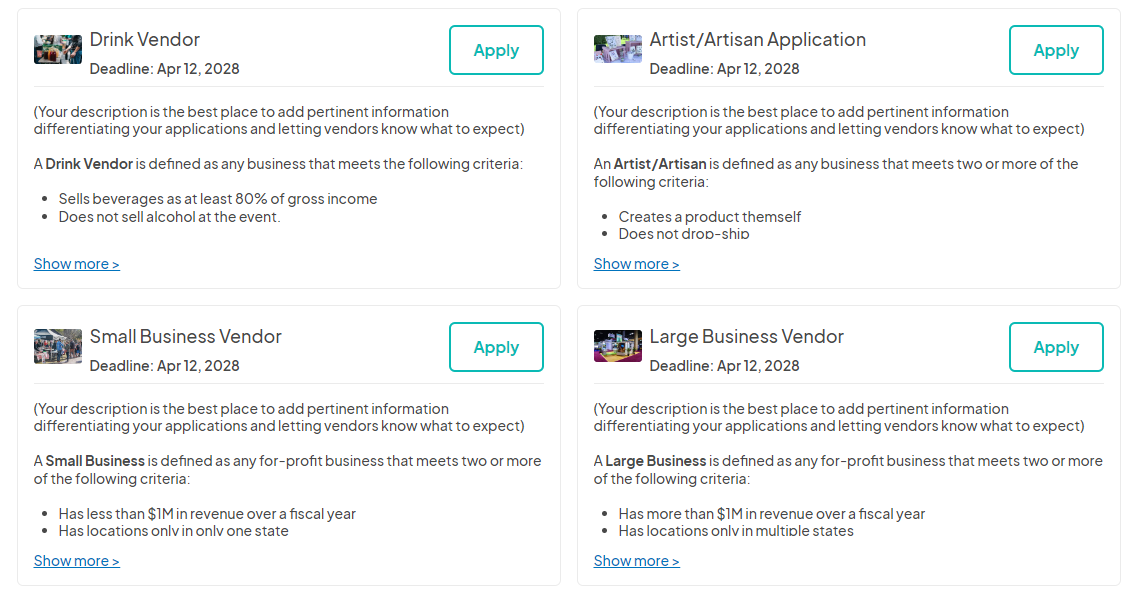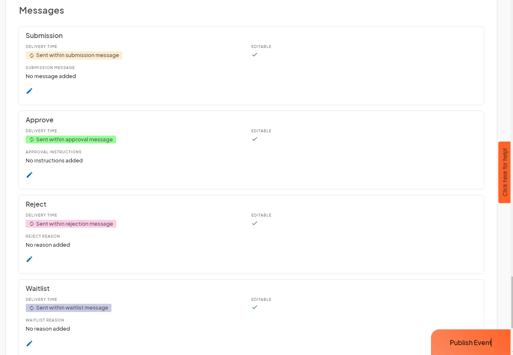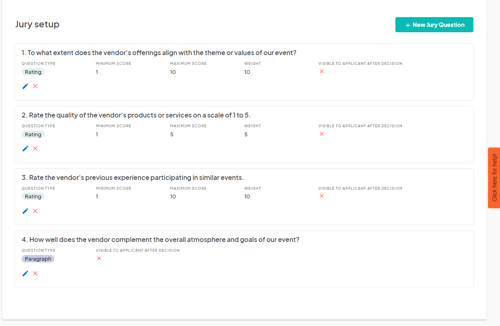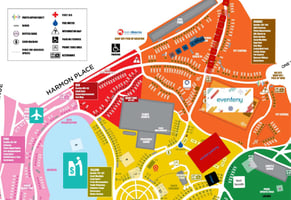In the world of event planning, particularly for festivals and events, smooth vendor onboarding is vital for success. Whether you're organizing a small community festival, a large-scale event, or a showing for small businesses, having a structured vendor application process can streamline operations and ensure you collaborate with the best partners. In this blog post, we'll offer event organizers like you the ultimate vendor application template to simplify your onboarding journey.
In this article, we will go over the key aspects of vendor applications to ensure :
Why create a streamlined vendor application process
Vendor onboarding is a critical process in event planning that requires careful attention to detail. By creating a well-designed vendor application template, establishing clear terms and conditions, asking relevant questions, providing transparent pricing, and maintaining effective communication, you can ensure a smooth onboarding journey for vendors and increase the chances of a successful event.
A well-designed vendor application template plays a significant role in simplifying the onboarding process and ensuring that you gather all the necessary information from potential partners. By providing a structured and organized application form, you can streamline operations and make the onboarding journey smoother for both parties involved.
The vendor application form should be clear, concise, and easy to understand. It should include sections for vendors to provide their contact details, business information, product offerings, and any specific requirements they may have. Additionally, it is essential to include a section where vendors can upload relevant documents, such as licenses, permits, and insurance certificates. The steps labeled below will give you good guidelines on what aspects to focus on for a good vendor application template to start your events with.
1. Creating a clear and concise application form:
Creating a good vendor application form is the first step towards efficient vendor onboarding. A customizable template allows you to tailor your application form to suit your specific event requirements. With intuitive design and user-friendly interface, you can easily create forms that capture all the essential information from vendors while ensuring a seamless experience for applicants. This form can help businesses capture what it is that is required from the event organizer to depict they would be a good vendor for your event,
Some features to consider are the location of where the event is to take place, the date and time, the description of a vendor, etc. These details are necessary for attendees of the event and should be easily accessible for the attendees to ensure a smooth event process. Moreover, they should be easy for the vendors to use as well. They should be aware of the finer details and expectations that you, as an event organizer, have so that there are no surprises or moments of miscommunication later down the line.
Here is an example of what various applications look like on our platform:

2. Establishing clear terms and conditions:
A successful vendor onboarding process must clearly outline both parties' rights and responsibilities regarding contact information, booth allocation, payment deadlines, cancellation policies, etc. By establishing clear terms and conditions, event organizers can minimize the risk of misunderstandings or disputes down the line and show what responsibilities vendors are responsible for.
Booth allocation
When it comes to booth allocation, it is important to specify the criteria and process for assigning booths to vendors. This could include factors such as seniority, product category, or booth size. By clearly outlining these criteria, vendors will better understand how booth allocation works and what they can expect.
Some vendor applications allow vendors to pick which booth they want to be assigned for preapproval, while others allow the event organizers to decide this. Eventeny offers the option of both, with prices that could be set depending on where the booth is located.
Payment deadlines
Payment deadlines should also be clearly stated in the terms and conditions. This includes the due date for booth fees, available installment options, and consequences for late payment. By setting clear payment deadlines, event organizers can ensure that vendors submit their payments on time, which is essential for proper event planning and budgeting.
Cancellation policies
Cancellation policies are another important aspect to address in the terms and conditions. Event organizers should outline the procedure for vendors who wish to cancel their participation and any refund policies or penalties that may apply. This information will help vendors make informed decisions and understand the financial implications of withdrawing their applications.
Additional details
In addition to booth allocation, payment deadlines, and cancellation policies, it is also beneficial to include other important details in the terms and conditions. This could include information on load-in and load-out procedures, liability and insurance requirements, noise restrictions, and any other rules or regulations vendors must adhere to.
Event organizers can set clear expectations and reduce the risk of misunderstandings or disputes by ensuring that vendors acknowledge and agree to these terms before submitting their applications. This creates a more professional and organized onboarding process and helps foster positive relationships with vendors, leading to long-term partnerships and successful events.
3. Vendor-specific questions:
A comprehensive set of general questions is crucial when designing your vendor application form. These questions are the foundation for gathering critical information from applicants, enabling you to make informed decisions when evaluating potential vendors. From essential contact details to insights into their business profile and previous experience, these questions ensure you have all the necessary information to assess vendors effectively. Some vital questions to include are:
- Business Name: This primarily identifies the vendor's business entity.
- Contact Name: Ensures clarity on who to communicate with regarding vendor-related matters.
- Address: Allows organizers to verify the vendor's location and facilitates communication.
- Email: Provides a reliable means of electronic communication with the vendor.
- Phone: Offers an alternative communication channel and ensures accessibility.
- Event References: Helps organizers assess the vendor's experience and track record at similar events.
- Website: Provides additional insights into the vendor's offerings, portfolio, and brand identity.
- Logo: Allows organizers to showcase vendor branding and promote consistency in event materials.
- Special Requests: Allows vendors to communicate any unique requirements or preferences.
In addition to these essential questions, it's important to include vendor-specific inquiries tailored to your event's needs and objectives. These questions can delve deeper into the vendor's offerings, capabilities, and alignment with your event's theme or audience. Consider asking about:
- Product/Service Offerings: Request details about the specific products or services the vendor intends to offer at the event.
- Booth Setup Requirements: Gather information on the vendor's booth setup preferences, including size, layout, and unique accommodations.
- Promotional Strategies: Explore the vendor's plans for engaging event attendees and driving foot traffic to their booth.
By incorporating these vendor-specific questions alongside the essential general inquiries, you can ensure a comprehensive and tailored vendor application form that facilitates effective evaluation and selection of vendors for your event. You can learn more about effective ways to onboard vendors here.
4. Transparency with prices for booths
Setting prices for booths can indeed be a complex and challenging task. However, it is crucial to establish transparent pricing structures and provide customizable options to ensure a smooth and efficient vendor onboarding process. By considering factors such as booth size, location, and amenities, you can create a pricing system that is fair and tailored to meet the needs of both the event and the vendors.
Transparency
Transparency is key when it comes to pricing. Vendors should have a clear understanding of what they are paying for and what they can expect in return. Clearly outlining the cost of booth rental, any additional fees or charges, and the services and amenities included in the price will help vendors make informed decisions and avoid any surprises or misunderstandings.
Customizable options
Customizable options are also important to accommodate the diverse needs and preferences of vendors. By offering different booth sizes, locations, and add-ons, you can provide vendors with the flexibility to choose what best suits their requirements and budget. This not only enhances their overall experience but also increases the chances of successful transactions and partnerships.
Consider market value of booths
When setting prices, it is important to consider the market value, competition, and the overall value proposition of your event. Conducting market research and analyzing the pricing strategies of similar events can help you determine a fair and competitive pricing structure. Additionally, it is essential to regularly review and adjust your prices based on market trends, vendor feedback, and the overall success of your event. Pricing could be done on the vendor registration form.
In conclusion, setting prices for booths and vendors requires careful consideration and transparency. By providing transparent pricing structures and customizable options, you can ensure that vendors have a clear understanding of what to expect and facilitate smooth transactions. Regularly reviewing and adjusting your prices based on market trends and vendor feedback will help you stay competitive and attract high-quality vendors to your event.
5. Submissions:
Communication is a vital aspect of the vendor onboarding process. It is crucial to keep vendors informed and engaged throughout the application process. One effective way to achieve this is by implementing instant notifications to vendors when they submit their applications. This ensures that they receive immediate confirmation and acknowledgment that their application has been received.
In addition to the initial notification, it is important to keep vendors informed of the status of their applications. Whether their application is approved, denied, or waitlisted, vendors should be kept in the loop. This not only helps manage their expectations but also allows them plan accordingly and make necessary adjustments to their participation in the event.
Customizable message templates can be utilized to streamline this communication process. These templates provide a consistent and clear format for communication, eliminating the need for manual follow-ups and ensuring that all vendors receive the same information. By customizing these templates to include specific details about the vendor's application and the status of their participation, event organizers can provide personalized communication without the need for extensive manual effort while simultaneously saving time.
Eventeny has a customizable messaging option for submissions that you can cater to your needs. An automatic system like this helps streamline the event-organizing process to make your life as an event organizer a lot easier.
6. Having a jurying option
What is jurying?
Jurying is used to score individual vendors after an event. For example, in a festival vendor application, one vendor could be an artist and members can rate this artist to pick their winning piece. For a farmers market vendor application, it could be about the quality of a vendor's fruit.
Some common questions asked would be:
- Rate the quality of the vendor's product or services on a scale of 1 to 5.
- To what extent do the vendor's offerings align with the theme or values of our event?
- Are the product options/ services they provide relevant to the theme of our event?
Importance of jurying
Implementing jurying questions for selecting vendors for an event brings a multitude of benefits. Firstly, it ensures an objective evaluation process by focusing on specific criteria rather than opinions. This structured framework promotes fair and unbiased decisions, resulting in a more successful event experience for attendees.
In addition, tailoring jurying questions to the event's specific needs enables organizers to see if a vendor has well-received products. This streamlined vendor selection process saves time and resources compared to traditional methods because it emphasizes the key factors that are important for the event. By encouraging team members and organizers to think critically about vendor offerings and their alignment with event needs, jurying questions facilitate informed decision-making.
 As can be seen in this image, Eventeny offers a jurying option that is easy to use and quick to set up. Of the options, there is a rating 1-5 system, a vote (yes/no) option, and a paragraph form for short-answer questions. This can be a useful tool for event organizers who want their volunteers or other team members to make a decision that is best fit for the vendor application process. You can learn more about jurying on Eventeny here.
As can be seen in this image, Eventeny offers a jurying option that is easy to use and quick to set up. Of the options, there is a rating 1-5 system, a vote (yes/no) option, and a paragraph form for short-answer questions. This can be a useful tool for event organizers who want their volunteers or other team members to make a decision that is best fit for the vendor application process. You can learn more about jurying on Eventeny here.
7. Conclusion
The ultimate vendor application template offers a comprehensive solution for effortless vendor onboarding. Features such as customizable application forms, clear terms and conditions, comprehensive vendor questions, transparent pricing, and automated messaging streamline the entire onboarding process, saving you time and ensuring a seamless experience for both organizers and vendors alike.
Want to stay in the know? Subscribe here to keep up with the latest news!

 As can be seen in this image, Eventeny offers a jurying option that is easy to use and quick to set up. Of the options, there is a rating 1-5 system, a vote (yes/no) option, and a paragraph form for short-answer questions. This can be a useful tool for event organizers who want their volunteers or other team members to make a decision that is best fit for the vendor application process. You can learn more about jurying on Eventeny here.
As can be seen in this image, Eventeny offers a jurying option that is easy to use and quick to set up. Of the options, there is a rating 1-5 system, a vote (yes/no) option, and a paragraph form for short-answer questions. This can be a useful tool for event organizers who want their volunteers or other team members to make a decision that is best fit for the vendor application process. You can learn more about jurying on Eventeny here.





